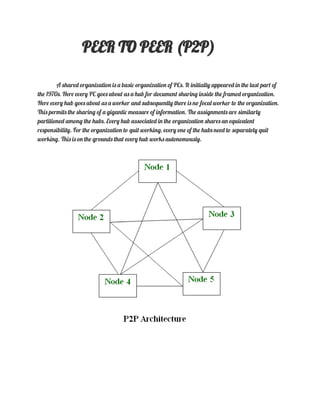
Peer to peer (p2p)
- 1. PEER TO PEER (P2P) A shared organization is a basic organization of PCs. It initially appeared in the last part of the 1970s. Here every PC goes about as a hub for document sharing inside the framed organization. Here every hub goes about as a worker and subsequently there is no focal worker to the organization. This permits the sharing of a gigantic measure of information. The assignments are similarly partitioned among the hubs. Every hub associated in the organization shares an equivalent responsibility. For the organization to quit working, every one of the hubs need to separately quit working. This is on the grounds that every hub works autonomously.
- 2. History of P2P organizations : Before the improvement of P2P, USENET appeared in 1979. The organization empowered the clients to peruse and post messages. Dissimilar to the gatherings we use today, it didn't have a focal worker. It used to duplicate the new messages to every one of the workers of the hub. After this, Napster was created which was a document sharing P2P programming. It very well may be utilized to share sound documents too. This product was closed down because of the unlawful sharing of records. However, the idea of organization sharing i.e P2P got mainstream. Types of P2P networks : 1. Unstructured P2P networks – In this type of P2P network, each device is able to make an equal contribution. This network is easy to build as devices can be connected randomly in the network. But being unstructured, it becomes difficult to find content. 2. Structured P2P networks – It is designed using the software which creates a virtual layer in order to put the nodes in a specific structure. These are not easy to set-up but can give easy access to users to the content. 3. Hybrid P2P networks – It combines the features of both P2P network and client-server architecture. An example of such a network is to find a node using the central server. Features of P2P network : These networks do not involve a large number of nodes, usually less than 12. All the computers in the network store their own data but this data is accessible by the group. Unlike client-server networks, P2P uses resources and also provides them. This results in additional resources if the number of nodes increases.It requires specialized software. It allows resource sharing among the
- 3. network. Since the nodes act as servers also, there is a constant threat of attack. Almost all the OS today support P2P networks. How to use a P2P network efficiently : Firstly secure your network via privacy solutions. Design a strategy that suits the underlying architecture in order to manage applications and underlying data. Keep a check on the cyber security threats which might prevail in the network. Invest in good quality software that can sustain attacks and prevent the network from being exploited. Update your software regularly. Advantages of P2P Network : ● Network is easy to maintain because each node is independent of each other. ● Since each node acts as a server, therefore the cost of the central server is saved. ● Adding, deleting and repairing nodes in this network is easy. Disadvantages of P2P Network : ● Because of no central server, data is always vulnerable to get lost because of no backup. ● It becomes difficult to secure the complete network because each node is independent. Examples of P2P networks : P2P networks can be basically categorized into three levels. The first level is the basic level which uses a USB to create a P2P network between two systems. The second is the intermediate level which involves the usage of copper wires in order to connect more than two systems. The third is the advanced level which uses software to establish protocols in order to manage numerous devices across the internet.